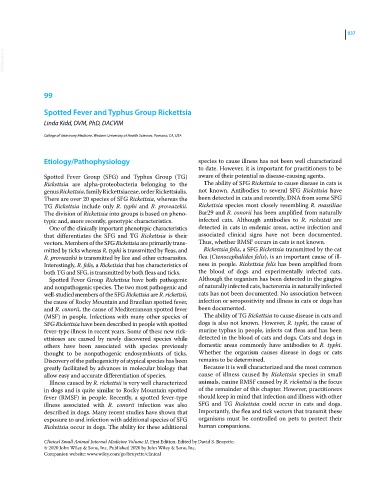Page 999 - Clinical Small Animal Internal Medicine
P. 999
937
VetBooks.ir
99
Spotted Fever and Typhus Group Rickettsia
Linda Kidd, DVM, PhD, DACVIM
College of Veterinary Medicine, Western University of Health Sciences, Pomona, CA, USA
Etiology/Pathophysiology species to cause illness has not been well characterized
to date. However, it is important for practitioners to be
Spotted Fever Group (SFG) and Typhus Group (TG) aware of their potential as disease‐causing agents.
Rickettsia are alpha‐proteobacteria belonging to the The ability of SFG Rickettsia to cause disease in cats is
genus Rickettsia, family Rickettsiaceae, order Rickettsialis. not known. Antibodies to several SFG Rickettsia have
There are over 20 species of SFG Rickettsia, whereas the been detected in cats and recently, DNA from some SFG
TG Rickettsia include only R. typhi and R. prowazekii. Rickettsia species most closely resembling R. massiliae
The division of Rickettsia into groups is based on pheno- Bar29 and R. conorii has been amplified from naturally
typic and, more recently, genotypic characteristics. infected cats. Although antibodies to R. rickettsii are
One of the clinically important phenotypic characteristics detected in cats in endemic areas, active infection and
that differentiates the SFG and TG Rickettsia is their associated clinical signs have not been documented.
vectors. Members of the SFG Rickettsia are primarily trans- Thus, whether RMSF occurs in cats is not known.
mitted by ticks whereas R. typhi is transmitted by fleas, and Rickettsia felis, a SFG Rickettsia transmitted by the cat
R. prowazekii is transmitted by lice and other ectoarasites. flea (Ctenocephalides felis), is an important cause of ill-
Interestingly, R. felis, a Rickettsia that has characteristics of ness in people. Rickettsia felis has been amplified from
both TG and SFG, is transmitted by both fleas and ticks. the blood of dogs and experimentally infected cats.
Spotted Fever Group Rickettsia have both pathogenic Although the organism has been detected in the gingiva
and nonpathogenic species. The two most pathogenic and of naturally infected cats, bacteremia in naturally infected
well‐studied members of the SFG Rickettsia are R. rickettsii, cats has not been documented. No association between
the cause of Rocky Mountain and Brazilian spotted fever, infection or seropositivity and illness in cats or dogs has
and R. conorii, the cause of Mediterranean spotted fever been documented.
(MSF) in people. Infections with many other species of The ability of TG Rickettsia to cause disease in cats and
SFG Rickettsia have been described in people with spotted dogs is also not known. However, R. typhi, the cause of
fever‐type illness in recent years. Some of these new rick- murine typhus in people, infects cat fleas and has been
ettsioses are caused by newly discovered species while detected in the blood of cats and dogs. Cats and dogs in
others have been associated with species previously domestic areas commonly have antibodies to R. typhi.
thought to be nonpathogenic endosymbionts of ticks. Whether the organism causes disease in dogs or cats
Discovery of the pathogenicity of atypical species has been remains to be determined.
greatly facilitated by advances in molecular biology that Because it is well characterized and the most common
allow easy and accurate differentiation of species. cause of illness caused by Rickettsia species in small
Illness caused by R. rickettsii is very well characterized animals, canine RMSF caused by R. rickettsii is the focus
in dogs and is quite similar to Rocky Mountain spotted of the remainder of this chapter. However, practitioners
fever (RMSF) in people. Recently, a spotted fever‐type should keep in mind that infection and illness with other
illness associated with R. conorii infection was also SFG and TG Rickettsia could occur in cats and dogs.
described in dogs. Many recent studies have shown that Importantly, the flea and tick vectors that transmit these
exposure to and infection with additional species of SFG organisms must be controlled on pets to protect their
Rickettsia occur in dogs. The ability for these additional human companions.
Clinical Small Animal Internal Medicine Volume II, First Edition. Edited by David S. Bruyette.
© 2020 John Wiley & Sons, Inc. Published 2020 by John Wiley & Sons, Inc.
Companion website: www.wiley.com/go/bruyette/clinical

